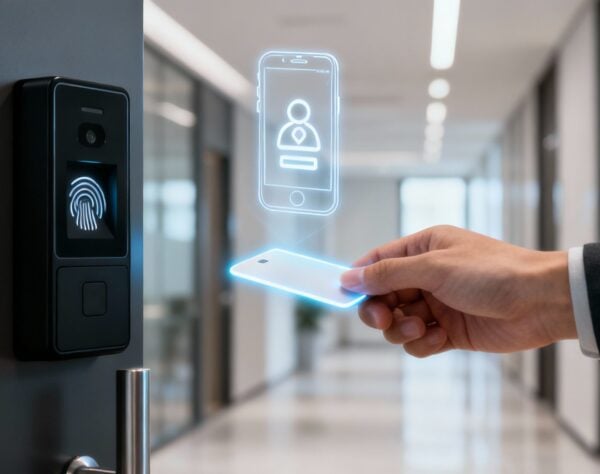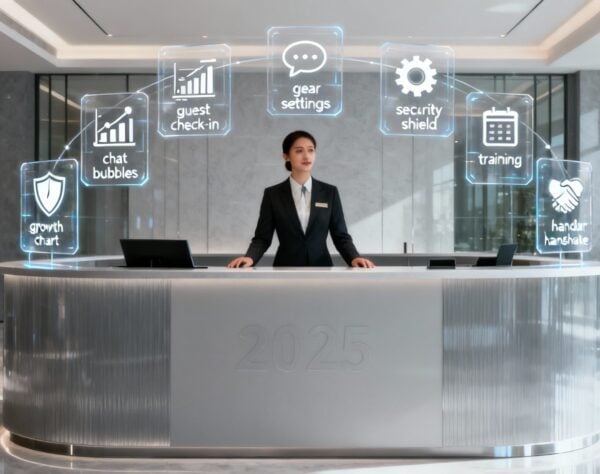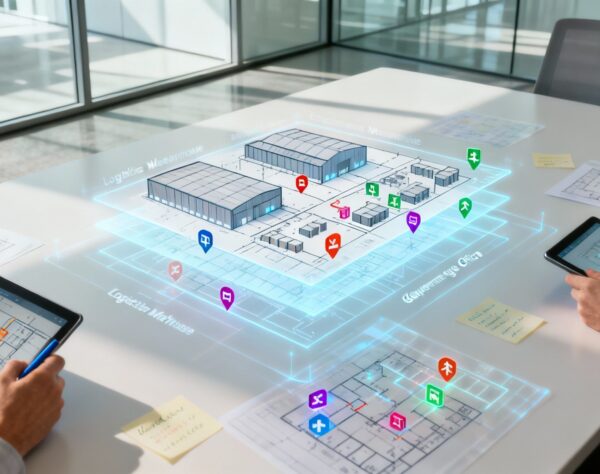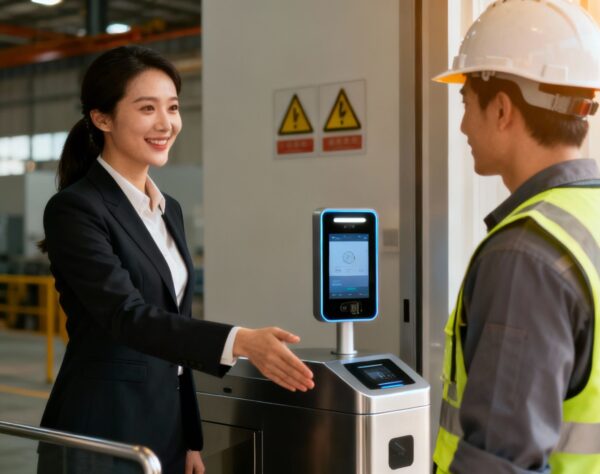
Effective Training for Reception Staff Guide
Investing in training for reception staff isn't just a cost—it's a critical business investment. A well-trained receptionist transforms your front desk from a simple check-in counter into a powerhouse for visitor satisfaction and operational security. This first impression is crucial; getting it right directly impacts your bottom line.
Why Investing in Reception Training Really Matters

The front desk is the first physical interaction a person has with your company. That initial moment shapes their entire perception of your business. A skilled, confident receptionist projects competence and warmth—direct reflections of your company's values.
The numbers don't lie. Research from Code of Talent reveals that 95% of guests are likely to return if they have a positive experience. Conversely, a single bad interaction can cause 20% of customers to leave for good. The negative impact spreads, with 67% of unhappy customers sharing their experience with others. Suddenly, an untrained staff member becomes a significant business risk.
The Strategic Value of a Trained Receptionist
A properly trained receptionist is more than an administrator; they are a strategic asset. They act as the first line of security and ensure daily operations run smoothly.
Key benefits include:
- Enhanced Security: A trained receptionist knows what to look for, effectively managing access to ensure only authorized individuals enter.
- Improved Efficiency: They handle unexpected visitor surges or problems seamlessly, maintaining a calm and productive workplace flow.
- Stronger Brand Image: Every positive interaction they create reinforces your company’s commitment to quality and professionalism.
A great receptionist is the ultimate brand ambassador. Their ability to manage first impressions directly influences visitor perception, turning a routine check-in into a memorable, positive experience that builds lasting trust.
Amplifying Skills with Modern Technology
Excellent training is amplified when paired with the right tools. A modern visitor management system empowers reception staff by automating repetitive tasks, freeing them to focus on high-value human interactions. Instead of being bogged down by manual logbooks, they can provide personalized attention, making visitors feel welcome and valued.
This technology provides instant access to visitor information and automates host notifications, ensuring safety protocols are met without sacrificing the guest experience. By handling the administrative burden, it allows your team's interpersonal skills to shine. Explore the full benefits of a visitor management system to see how it can elevate your front desk operations.
Building a Modern Reception Training Program
Outdated reception training no longer suffices. Today's effective programs require a dynamic, skills-focused approach that prepares your team for the realities of a modern front desk.
This isn't just about processes; it's about building confidence to handle any situation. A blend of self-paced learning for technical skills and hands-on, scenario-based practice for crucial soft skills is essential. The goal is to identify and close skill gaps, ensuring your investment delivers a reception team that's ready for anything.
Identifying Core Competencies
Before building a program, you must define which skills are most critical. While one survey found 98.6% of receptionists received some training, it often focused on basics like customer service (72.9%) and telephone skills (64.3%). A modern curriculum must go deeper.
Key competencies for today’s reception staff include:
- Digital Proficiency: Staff must master your technology, including the visitor management system. This ensures faster, more secure check-ins and allows them to focus their full attention on the guest.
- Emotional Intelligence: Training in empathy, active listening, and conflict de-escalation is what separates a good receptionist from a great one. A study by DDI shows that empathy is a key driver of leadership success and, by extension, customer satisfaction.
- Security and Safety Protocols: Your front desk is your first line of defense. Staff must be trained to recognize security risks, verify identities, and execute emergency procedures. A visitor management system provides the data, but training ensures staff can act on it decisively.
A well-structured training program transforms a receptionist from a simple gatekeeper into a strategic front-desk coordinator. By equipping them with the right blend of technical and soft skills, you enable them to create secure, efficient, and welcoming experiences that reflect positively on your brand.
To help you structure this, here’s a breakdown of essential training modules and how they connect directly to the benefits of using a visitor management system.
Essential Training Modules for Modern Reception Staff
| Training Module | Core Skills Covered | Benefit with Visitor Management System |
|---|---|---|
| System & Tech Mastery | Navigating the VMS dashboard, QR code generation, badge printing, troubleshooting common issues. | Frees up staff from manual data entry to focus on high-value personal interactions and visitor experience. |
| Security & Emergency Protocols | Visitor identity verification, watchlist alerts, executing evacuation procedures, data privacy (GDPR/CCPA). | Enhances the system’s security features by ensuring staff can act decisively on alerts and use visitor logs effectively in an emergency. |
| Emotional Intelligence & Conflict Resolution | Active listening, empathy, de-escalating tense situations, managing visitor expectations. | Allows staff to handle difficult visitors or unexpected delays with professionalism, complementing the system’s automated notifications. |
| Communication & Professional Etiquette | Greeting visitors, clear verbal communication, host notification etiquette, managing deliveries. | Ensures the human element of the visitor journey is as smooth and professional as the digital check-in process. |
By weaving these modules together, you create a holistic program where the technology and the human touch work in perfect harmony, boosting both security and hospitality.
Structuring a Blended Learning Program
A one-size-fits-all lecture is ineffective. A blended learning approach is far more successful, respecting your team's time by using the right method for each skill.
You can use self-guided online modules for technical training and in-person role-playing for customer service scenarios. This acknowledges that different skills are learned in different ways.
This flow is key to developing a well-rounded receptionist.

As you can see, foundational soft skills like listening are the gateway to being able to use systems and etiquette effectively.
By automating mundane tasks, modern front desk software gives your team the mental bandwidth to apply these higher-level skills. For a deeper look at practical ways to develop your team, check out these effective call center training strategies—many of the core principles are directly applicable to front desk training. This ensures your program is not just well-rounded, but also practical and engaging for your staff.
Integrating Technology for a Smarter Front Desk

Technology isn’t here to replace your skilled reception staff; it’s here to amplify their most valuable skills. The best training for reception staff today shows them how to use technology as a tool to create better, safer, and more efficient visitor experiences.
A visitor management system fundamentally upgrades your receptionist's role. Their focus shifts from tedious manual tasks toward high-value human interaction. A study from the World Economic Forum confirms that as technology handles routine work, the demand for human skills like communication and empathy soars. This is where your team can provide a personal touch no machine can replicate.
Enhancing Security and Efficiency
Integrating technology provides an immediate and significant boost to building security. A trained receptionist using a visitor management system can instantly check visitors against pre-approved lists or internal watchlists, transforming them from a simple greeter into an active, informed part of your security protocol.
Instead of a paper logbook, they oversee a digital process where every visitor is accounted for. This creates an accurate, real-time record of everyone on-site—a critical asset during an emergency evacuation. This is especially true for third-party staff. Learn more about using new technology to ensure the safety of your contractors and other non-employee visitors.
By automating check-ins and host notifications, a visitor management system gives your receptionist the two things they need most: time and information. This allows them to manage busy periods without breaking a sweat, all while keeping security and professionalism front and centre.
Creating a Superior Visitor Experience
A fantastic visitor experience often begins before a person even arrives. A visitor management system enables pre-registration, allowing guests to complete necessary paperwork or watch safety videos from their own device. According to a Cvent report, 77% of event planners see event technology as a key factor in improving the attendee experience.
This one step has a huge impact by drastically cutting wait times and shaping a positive first impression.
Consider these scenarios:
- High-Volume Traffic: During a large meeting, your receptionist can manage dozens of people effortlessly. Visitors scan a QR code, print their badge, and proceed, eliminating long queues and freeing up your receptionist to offer personal greetings.
- Handling Unexpected Issues: If a visitor arrives and their host is unavailable, the system’s instant notifications allow the receptionist to see the problem immediately. They can proactively find an alternative contact, turning a potential headache into a moment of exceptional service.
Ultimately, the best training empowers your team to use technology to master their environment. It gives them the tools to not just manage the front desk, but to control it, ensuring every interaction is secure, efficient, and impressively professional.
Mastering Soft Skills for Memorable Visitor Experiences
Your team can master your visitor management system, but technical know-how only goes so far. The real magic happens with the human touch.
The most advanced tech can check someone in, but it can’t show genuine empathy to a frustrated guest. This is where your people become your greatest advantage. Exceptional training for reception staff must dive deep into interpersonal skills, transforming a routine check-in into a positive moment that reflects well on your brand.
This isn’t just a nice-to-have. A World Economic Forum report highlighted that as technology handles routine tasks, skills like communication and problem-solving become even more valuable. This creates a significant opportunity for your front desk team to shine.
From Conflict to Connection
Your front desk is often the first stop for complaints. How your receptionist navigates these tense moments can make or break a visitor's experience. With the right skills, a problem becomes a chance to demonstrate your company's commitment to service.
Your training needs to include practical, real-world role-playing.
- Active Listening: This means training staff to truly hear and understand a visitor's issue without jumping to conclusions. A study by Salesforce found that 84% of customers say the experience a company provides is as important as its products.
- Empathetic Responses: Move beyond a robotic "I understand." Train them to genuinely acknowledge the visitor's feelings and show they are ready to find a solution.
- Problem-Solving: Give your team the autonomy to fix issues on the spot. Resolving a problem directly demonstrates competence and builds trust.
When a receptionist turns a negative situation around, they aren't just solving one problem—they're building loyalty. That ability to handle pressure with grace comes directly from targeted soft skills training.
A visitor management system and your people create a powerful partnership. By automating administrative work, the system frees up your team's time and mental space, allowing them to focus their energy on delivering high-value, personal engagement.
To elevate your front desk from a processing station to a hospitality hub, explore the concept of a Reception Lobby Ambassador. This approach re-frames the role to be proactive and hospitality-focused, curating a fantastic first impression that lasts.
Measuring Training Success and Driving Improvement
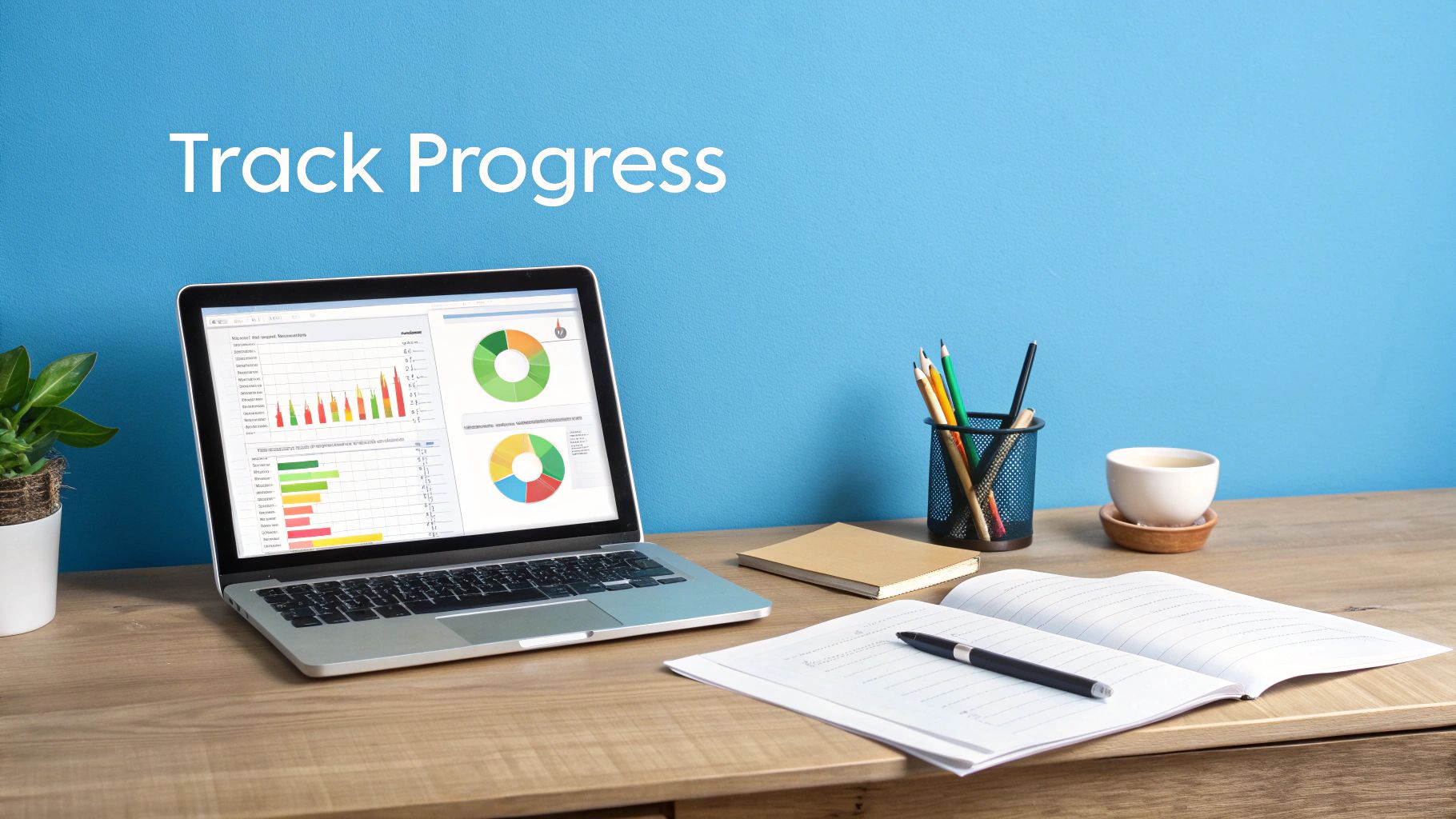
You’ve invested in training for reception staff, but how do you know if it's working? Without clear metrics, you're just guessing. True success is seeing tangible improvements in efficiency, security, and the visitor experience.
The most direct way to measure impact is by tracking key performance indicators (KPIs). A good visitor management system simplifies this by providing an analytics dashboard to monitor the data that tells the story of your training's success.
Tracking Key Performance Indicators
Let the data do the talking. The right technology provides solid proof of your training's ROI. Focus on a few core KPIs:
- Visitor Check-in Times: A steady decrease in the average sign-in time is a clear indicator that your team is mastering the process.
- Error Rates: A drop in incomplete visitor logs or incorrect host notifications demonstrates improved accuracy and attention to detail.
- Guest Satisfaction Scores: A simple, automated one-question survey sent after a visit provides invaluable feedback. According to Qualtrics, companies that lead in customer experience outperform laggards by nearly 80%. A rising satisfaction score is the ultimate validation.
A visitor management system's real power isn't just in streamlining check-ins; it's in giving you the hard data to prove your training is effective. It turns daily front-desk activities into measurable outcomes, so you can confidently show the positive impact on your business.
Gathering Qualitative Feedback
Numbers tell you what is happening, but not always why. To get the full picture, you need to talk to people. Gathering insights from both staff and visitors is crucial. Understanding how to effectively gather customer feedback can unlock actionable ideas you'd never find in a spreadsheet.
Fostering a Culture of Continuous Learning
The front desk environment is dynamic. New technology, shifting priorities, and staff turnover are constants. The U.S. Bureau of Labor Statistics projects about 137,800 job openings for receptionists each year, highlighting the need to get new hires up to speed efficiently.
This makes a "one-and-done" training approach obsolete. The best front desks are built on a culture of continuous learning. By regularly reviewing performance data and staff feedback, you can make iterative tweaks to your training. This approach keeps your team sharp and boosts morale by showing you’re invested in their growth. Our guide on what a visitor management system is explores how the right tools can support this ongoing process.
Frequently Asked Questions
When you're putting together a training plan for your front desk team, questions always pop up. It's a critical role, so it's natural to want to get it right. Let's walk through some of the most common questions managers have and give you some clear, practical advice for building a skilled and confident reception team.
How Long Should Reception Training Take?
Honestly, there's no magic number here. The right amount of time really depends on how complex the role is and how much experience your new hire already has.
What works best is an intensive kick-off period—think a few solid days—followed up with ongoing microlearning sessions. Get the core systems and procedures down first. For example, a good visitor management system simplifies the whole check-in process, which means you can spend less time on technical training and more on the soft skills that really matter.
The real goal isn't just to check a box and say training is "done." It's about reaching proficiency. A Qualtrics study found that a whopping 95% of guests will likely return after a positive experience, so investing the time to get those interactions right is a no-brainer.
What Is the Most Important Skill for a Receptionist?
While knowing the systems is a must, you could argue that strong communication skills are the absolute game-changer. This isn't just about talking clearly; it's about active listening and showing real empathy, especially when things get tricky.
A receptionist who is a great communicator turns the front desk from a simple checkpoint into a genuinely welcoming hub. This one skill underpins everything else, from handling a frustrated visitor to being the living embodiment of your brand. When you automate the admin work with a visitor management system, you give your team the breathing room to focus on these high-value human interactions where their communication skills can truly shine.
How Can We Make Training More Engaging?
Nobody learns well from a dry lecture or a massive manual. The best training is hands-on and mirrors the real challenges your team will face every single day.
- Role-Play Scenarios: Don't just talk about it, do it. Run drills for common situations, like managing a sudden rush of visitors or helping someone who is upset. It’s a safe way to build confidence and sharpens problem-solving skills.
- Use Their Actual Tools: Get your staff training on the exact technology they'll be using. If they can get comfortable with the visitor management system's dashboard from day one, the training feels practical and immediately useful.
- Try Blended Learning: Mix it up. Use self-paced online modules for the technical stuff and save your in-person time for practicing soft skills. This hits all the different ways people learn and keeps things from getting stale.
Giving your team the right tools is how you empower them to put all that great training into practice. VisitUs offers a powerful platform that's incredibly easy to use. It automates admin tasks, tightens up security, and frees your reception staff to deliver the kind of standout visitor experiences that make your brand memorable.


